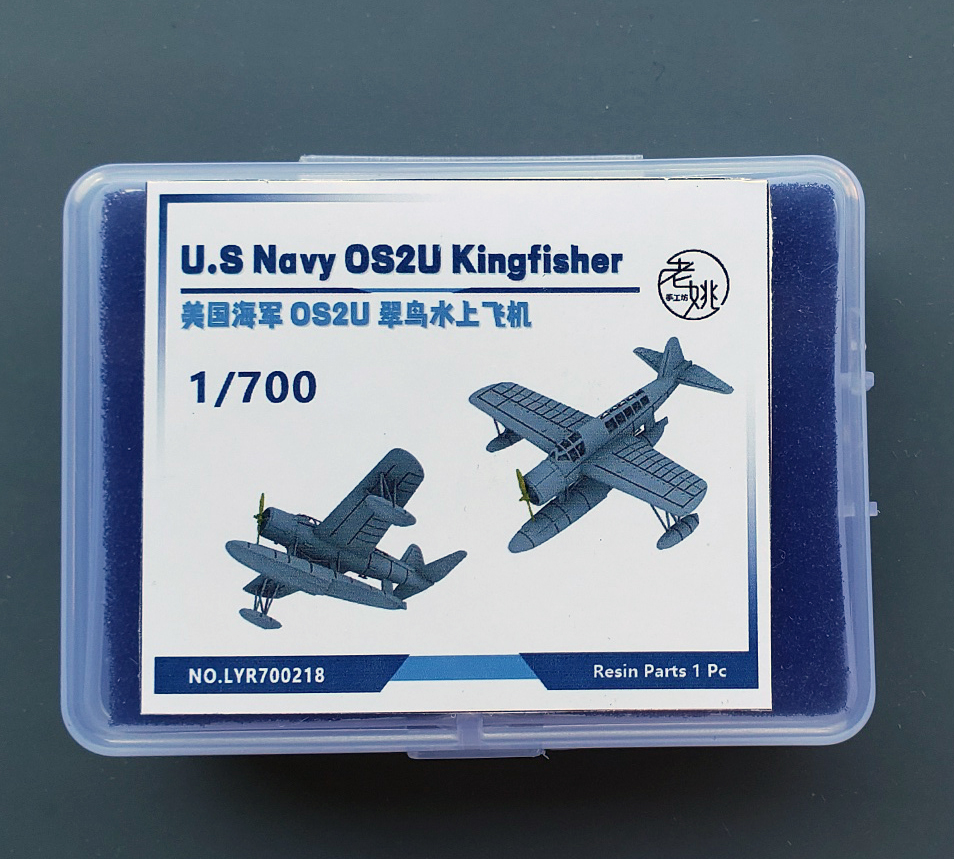|
Developed in
the late 1930s as a modern monoplane replacement for the US Navy’s biplane
observation aircraft, the OS2U Kingfisher was the standard shipboard observation
and reconnaissance aircraft used by the Navy during WW 2. It was a catapult
launched, two-seat (pilot and gunner/radio operator) floatplane, with a
large central and two wingtip floats. Fixed wheel, land-based versions
were utilized as well. Just over 1,500 aircraft were produced by Vought.
It had a relatively low powered engine offering modest performance,
yet it excelled in scouting, gunnery observation, flight training, ASW
reconnaissance, and air-sea rescue missions. It was used on the US Navy’s
battleships, its heavy and light cruisers, and with the Navy’s coastal
air stations. It also served
notably with the US Coast Guard, the US Marine Corp., the Royal Navy
‘s Fleet Air Arm, the Soviet Navy, and several lesser navies.
It’s replacement, the Curtiss Seahawk, began arriving in the fleet in
late 1944, but most Kingfishers remained in service throughout the conflict. |
| The
Review Item: Yao's Studio 1/700 OS2U Kingfisher
Unintentionally, I seem to be slowly working my
way through the 1/700 OS2U Kingfisher aftermarket replacements offerings.
This item appeared unexpectedly in the spring of this year on eBay, made
by Yao’s Studio. I felt compelled to purchase a set, given my dissatisfaction
with the options I’ve worked on so far – the styrene injection version
from Trumpeter for its cage mast battleship kits, and a resin version from
Orange Hobby.
I don’t know much about this new Chinese company,
only that they have an expanding line of 3D printed accessories in both
1/700 and 1/350 scale for a variety of navies. As far as I can tell, they
sell directly to consumers via their own “store” on eBay, and via Ali Express,
which is a major Chinese e-commerce site similar to Amazon.
This set comes as a set of six fully printed, one-piece
Kingfishers. They are collectively printed on one printing raft, which
has been formed to act as a cage to shield the contents. The entire cage
comes within a sturdy, polystyrene container, with foam wrapped around
the print raft. It is a very smartly packaged set, compact, and well-protected.
I did not open the “cage” to enable an extreme
close-up examination of the set, but the open bars allowed for a reasonably
good look at the aircraft. I think it an impressive printing. Each Kingfisher
is nearly complete, with fully formed canopy frames, exposed radial engine,
and the main and wing floats connected to the aircraft by individual support
struts. Only the two bladed propeller for each is printed separately, set
on its own attachment points on the base of the raft.
Overall, the printing looks particularly smooth,
with a minimum of obvious print lines. The lines and dimensions of the
Kingfishers appear to be quite good. Perhaps the only “knock” is that the
depth of the wing chord at the wing root looks a little narrow to my eye
from overhead, but I think one would be hard-pressed to really tell. The
wind dihedral looks correct as well, with no sag or waviness as is sometimes
seen in a 3D printed wing. The attachment points are tiny, which hopefully
will mean a minimum of effort to remove them. |
| This set
is clearly superior to the Trumpeter or Orange Hobby offerings in both
shape and presentation. Tom’s Modelworks has introduced its own 1/700 3D
printed Kingfisher, but their units come with solid canopies. As much as
I like the Tom’s versions, I prefer these open canopies.
The Yao Studio units require almost
no assembly prior to painting, which is cannot be said of the Trumpeter
or Orange Hobby versions. The amount of work required to assemble those
units is prohibitive and difficult. Nor can one be guaranteed of an acceptable
outcome. Here, the outcome is obvious.
It is not clear if the Yao’s Studio
resin requires some kind of wash prior to painting, but it couldn’t hurt
to soak the resin in a mild mix of dish soap and warm water for a bit,
just in case.
Obviously, much care must be taken
in removing the attachment points. I would suggest studying the attachment
layout very carefully as it pertains to the areas around all the floats.
You do not want to accidentally remove a float support. I can also see
removal of the two bladed propeller being problematic. In this instance,
access to some brass PE propellers would be a benefit.
Given the need for delicate handling,
as well as the need to source one’s own decals, this offering is not for
beginners. That said, it appears to be a quality product and highly recommended
as a replacement for any of the current 1/700 OS2U Kingfishers that typically
comes with their respective ship kits.
I am aware that Black Cat has just
announced its own 3D printed version of this aircraft in 1/700. That’s
a review for another day.
This set came courtesy of my wallet
via Ebay.com. The cost then was $15.99 plus $4 shipping via Speed Pak.
That option remains in effect as of this writing. |



